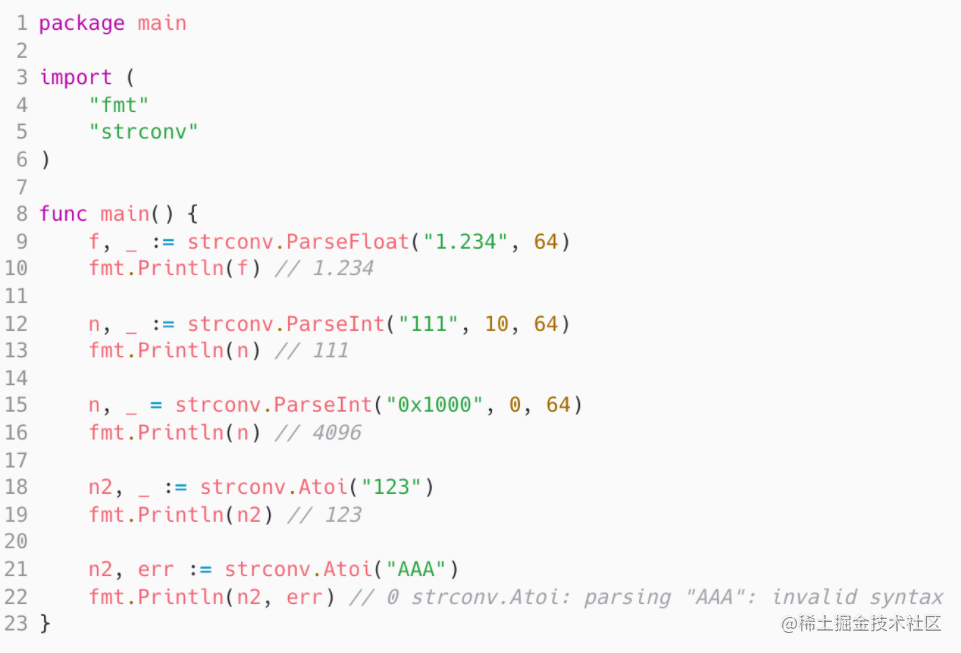走进 Go 语言基础语法 | 青训营
摘要
Title: 走进 Go 语言基础语法 | 青训营
Tag: ByteDance、Go、后端
Powered by:NEFU AB-IN
走进 Go 语言基础语法 | 青训营
- Go 语言入门指南:基础语法和常用特性解析
-
go.mod
go.mod 这个文件里记录了当前项目里所有依赖包的 git 仓库地址以及对应的版本号,来解决了包依赖管理的问题,后续在构建编译时,就会根据对应的版本号去拉取依赖包。
注意, 如果当前的项目是要给外部使用的,最好是配合 git 仓库命名,比如
1
go mod init github.com/lincoln/manage
1
2go get ... // 获取包
go mod tidy // 将会扫描所有我们 import 到的包,并生成对应的记录到 gomod 文件里 -
笔记代码注释
1
2
3
4
5
6
7
8
9
10
11
12
13
14
15
16
17
18
19
20
21
22
23
24
25
26
27
28
29
30
31
32
33
34
35
36
37
38
39
40
41
42
43
44
45
46
47
48
49
50
51
52
53
54
55
56
57
58
59
60
61
62
63
64
65
66
67
68
69
70
71
72
73
74
75
76
77
78
79
80
81
82
83
84
85
86
87
88
89
90
91
92
93
94
95
96
97
98
99
100
101
102
103
104
105
106
107
108
109
110
111
112
113
114
115
116
117
118
119
120
121
122
123
124
125/*
* @Author: NEFU AB-IN
* @Date: 2023-08-06 09:44:15
* @FilePath: \GoTest\1.go
* @LastEditTime: 2023-08-06 22:57:59
*/
package main
import (
"bufio"
"fmt"
"os"
"strconv"
)
var (
in = bufio.NewReader(os.Stdin)
out = bufio.NewWriter(os.Stdout)
)
func Read[T any]() T {
var i T
fmt.Fscan(in, &i)
return i
}
const N int = 1e5 + 10
// 函数
func add(a int, b int) (v int, ok bool) {
return a + b, ok
}
func add2(a *int) {
*a += 2
}
// 结构体
type sa struct {
x int
y int
}
// 结构体方法(类成员函数)
func (a sa) add(x int) bool {
return a.x == 2
}
func main() {
defer out.Flush()
// 1. variable
a := "123"
var b int = 2
var c int64
/*
int 类型大小为 8 字节
int8 类型大小为 1 字节
int16 类型大小为 2 字节
int32 类型大小为 4 字节
int64 类型大小为 8 字节
*/
var d float64
e := a + "foo"
const s = "1231"
fmt.Println(a, b, c, d) // 带换行
fmt.Print(s) // 不带换行
fmt.Println(e)
// 2. if else
f := Read[int]()
if f%2 == 0 {
print("even")
} else {
print("odd")
}
// 3. 循环
for i := 0; i < 10; i++ {
fmt.Print("!")
}
// 4. 数组 两种声明方式
var g [N]int
var h = [N]int{}
fmt.Println(g[1:2], h[2:3])
// 5. slice 切片
j := make([]string, 3)
j = append(j, "cc")
fmt.Println(j[2:5])
// 6. map
mp := map[string]int{}
mp["xw"] = 100
mp["lsy"] = 12
l, ok := mp["xw"]
fmt.Println(l, ok)
delete(mp, "xw")
for key, val := range mp {
fmt.Println(key, val)
}
// 7. 给构体
m := sa{x: 10}
fmt.Println(m)
// 8. 格式化
fmt.Printf("f=%v\n", f)
fmt.Printf("f=%+v\n", m)
fmt.Printf("f=%#v\n", m)
// 9. 转换
y := 10
z := "123"
fmt.Println(strconv.Atoi(z))
fmt.Println(strconv.Itoa(y))
}另外字符串和数字互相转换的例子

-
JSON处理
1
2
3
4
5
6
7
8
9
10
11
12
13
14
15
16
17
18
19
20
21
22
23
24
25
26
27
28
29
30package main
import (
"encoding/json"
"fmt"
)
type Student struct {
Name string `json:"name"` // 字段名的第一个字母大写
Sid string `json:"sid"`
}
func main() {
s := Student{Name: "jonh" ,Sid: "10323"}
//序列化
p ,err := json.Marshal(s) // 序列化
if err!=nil {
panic(err)
}
fmt.Println(string(p)) // 不加string的话就是一些16进制的编码
// {"name":"jonh","sid":"10323"} 因为加了tag,导致变为小写
//反序列化
err = json.Unmarshal(p,&s)
if err!=nil {
panic(err)
}
fmt.Printf("%#v\n", s) // main.Student{Name:"jonh", Sid:"10323"}
} -
时间库的使用
1
2
3
4
5
6
7
8
9
10
11
12
13
14
15
16
17
18
19
20
21
22
23
24
25
26
27package main
import (
"fmt"
"time"
)
func main() {
now := time.Now() //获取当前时间
fmt.Printf("current time:%v\n", now)
year := now.Year() //年
month := now.Month() //月
day := now.Day() //日
hour := now.Hour() //小时
minute := now.Minute() //分钟
second := now.Second() //秒
fmt.Printf("%d-%02d-%02d %02d:%02d:%02d\n", year, month, day, hour, minute, second)
now1 := time.Now() //获取当前时间
timestamp1 := now1.Unix() //时间戳
timestamp2 := now1.UnixNano() //纳秒时间戳
later := now1.Add(time.Hour) // 当前时间加1小时后的时间
fmt.Printf("现在的时间戳:%v\n", timestamp1)
fmt.Printf("现在的纳秒时间戳:%v\n", timestamp2)
fmt.Println(later)
} -
CF代码模板
1
2
3
4
5
6
7
8
9
10
11
12
13
14
15
16
17
18
19
20
21
22
23
24
25
26
27
28
29
30
31
32
33
34
35
36
37
38
39
40
41/*
* @Author: NEFU AB-IN
* @Date: 2023-08-06 22:57:54
* @FilePath: \GoTest\tmp.go
* @LastEditTime: 2023-08-06 23:05:28
*/
package main
import (
"bufio"
"fmt"
"os"
)
var (
in = bufio.NewReader(os.Stdin)
out = bufio.NewWriter(os.Stdout)
)
func Read[T any]() T {
var i T
fmt.Fscan(in, &i)
return i
}
const N int = 1e5 + 10
func solve() {
}
func main() {
defer out.Flush()
T := Read[int]()
for T > 0 {
solve()
T--
}
}
